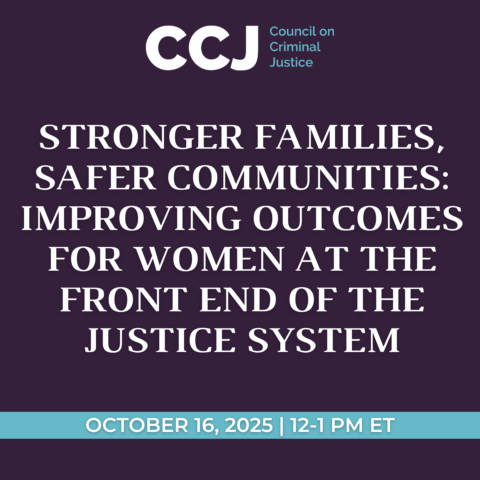Expert panel says increased government oversight, body-worn cameras, and national database of decertified officers are key to enhance accountability, transparency
5:00 a.m. ET, April 15, 2021
Contact: Jenifer Warren
jwarren@counciloncj.org
916-217-0780
WASHINGTON, D.C. – The U.S. Department of Justice should dramatically expand its capacity to investigate police misconduct and propose and enforce reforms, the Council on Criminal Justice Task Force on Policing said today in a new set of policy recommendations.
Reforms adopted following federal “pattern-or-practice” investigations of police agencies led to decreases in police misconduct – including improper stops, searches, seizures, and arrests – as well as reductions in public complaints against officers, the Task Force noted. While more rigorous research is needed, one study found that agencies with consent decrees that included the appointment of a federal monitor reported significantly fewer police killings. Other benefits have included the development of new officer wellness programs and fewer civil litigation judgments and settlements.
The recommendation for more aggressive federal oversight was contained in a set of new research-based reports that also called for enhanced intervention by state attorneys general, more consistent use of body-worn cameras, and a national database of decertified officers as measures to better hold police accountable for misconduct and rebuild public trust in law enforcement.
The Task Force of 11 law enforcement, civil rights, and community leaders said that despite a wave of reforms following last year’s death of George Floyd, efforts to address excessive use-of-force cases and other officer misconduct too often come up short, leaving the victim uncompensated and the wrongdoer unpunished.
Specifically, the continued employment of officers who are terminated in one agency only to find positions elsewhere undermines disciplinary efforts, puts communities at risk, and erodes public confidence in police. With decertification on the agenda in Washington and in dozens of state legislatures this spring, the Task Force provided guidance to shape effective decertification policies – and urged federal officials to step in.
“Police officers who misuse force once are more likely to do so again,” the Task Force said. To remove officers who are unfit to serve and help deter misconduct, the federal government should create national decertification standards, establish a national, publicly accessible police misconduct registry, and use funding incentives to encourage police agencies to contribute records.
The Task Force also said that while evidence suggests body-worn cameras can reduce public complaints and potentially curb police use of force, and that new research from the University of Chicago Crime Lab shows the benefits of such devices likely outweigh their cost, many officers do not activate their cameras consistently, undermining their value. To enhance the effectiveness of body-worn cameras, which are used by nearly half of all U.S. police agencies, jurisdictions should require officers to turn them on during interactions with the public, and hold officers accountable for failing to do so.
Other highlights of the Task Force assessments include:
- Civilian oversight panels, which operate in more than 160 U.S. jurisdictions, typically suffer from inadequate resources, political support that wanes over time, and other barriers that prevent them from achieving their goals and fulfilling public expectations. Other mechanisms should be used to solicit community engagement and enhance the transparency of police accountability procedures.
- While internal police agency investigations are necessary, they often fail to hold departments and officers fully accountable for misconduct. Policymakers can address enforcement gaps by passing laws clarifying the definition of use of force and civil rights violations and by creating independent state and local government oversight through inspectors general, police auditors, and prosecutors’ offices, including state attorneys general.
- Along with an expansion of “pattern-or-practice” investigations, the Justice Department should substantially expand its voluntary Collaborative Reform Initiative, which provides police departments with a review of agency policies and practices and offers technical assistance.
“With more than 1,000 community members losing their lives in encounters with law enforcement each year, it is crucial that our systems of investigation, indictment, and prosecution of police officers are transparent and equitable, and that we hold the guilty accountable,” said Task Force Executive Director Nancy La Vigne. “Using the most recent and rigorous research to guide them, Task Force members have produced a set of recommendations that can help us fix what is broken.”
The reports are the third batch released by the Task Force, which issued recommendations on chokehold bans, duty-to-intervene policies, and no-knock warrants in January, and highlighted widespread deficiencies in police training in March. Established in November 2020, the panel is evaluating the most commonly proposed reforms focused on preventing police use of excessive force, reducing racial biases, increasing police accountability, and improving the relationship between law enforcement agencies and communities. For each measure, the Task Force produces an assessment weighing the proposal’s relative value based on the best available research and the expertise and experience of members. An upcoming brief will address the additional accountability issues of qualified and sovereign immunity.
Task Force members represent a diverse range of perspectives and experience, and include law enforcement leaders, civil rights advocates, researchers, a former big-city mayor, and community members who have lost loved ones to police violence. The Crime Lab at the University of Chicago’s Harris School of Public Policy is serving as research partner for the Task Force, evaluating the empirical evidence that guides its recommendations.
The Task Force members are:
- Art Acevedo, Chief, Miami Police Department; President, Major Cities Chiefs Association
- Roy L. Austin, Jr., Partner, Harris, Wiltshire & Grannis, LLP; former White House domestic policy adviser
- Louis M. Dekmar, Chief, LaGrange (Ga.) Police Department; former President, International Association of Chiefs of Police
- Collette Flanagan, Founder, Mothers Against Police Brutality
- Walter Katz, Vice President of Criminal Justice, Arnold Ventures; former police oversight official, Los Angeles County and San Jose, Calif.
- Cynthia Lum, Professor, George Mason University, Department of Criminology, Law and Society; Director, Center for Evidence-Based Crime Policy
- Tashante McCoy, Regional Manager and Founder, Crime Survivors for Safety & Justice/The OWL Movement
- DeRay Mckesson, Educator, Author and Co-Founder, Campaign Zero
- Michael Nutter, Former Mayor, City of Philadelphia; former President, U.S. Conference of Mayors
- Sean Smoot, Director and Chief Counsel, Police Benevolent and Protective Association of Illinois
- Rosie Rivera, Sheriff, Salt Lake County, Utah
About the Council on Criminal Justice
The Council is a nonpartisan membership organization and think tank created to advance understanding of the criminal justice policy challenges facing the nation and builds consensus for solutions based on facts, evidence, and fundamental principles of justice.
For more information on the Council and the Task Force, visit https://counciloncj.org/




